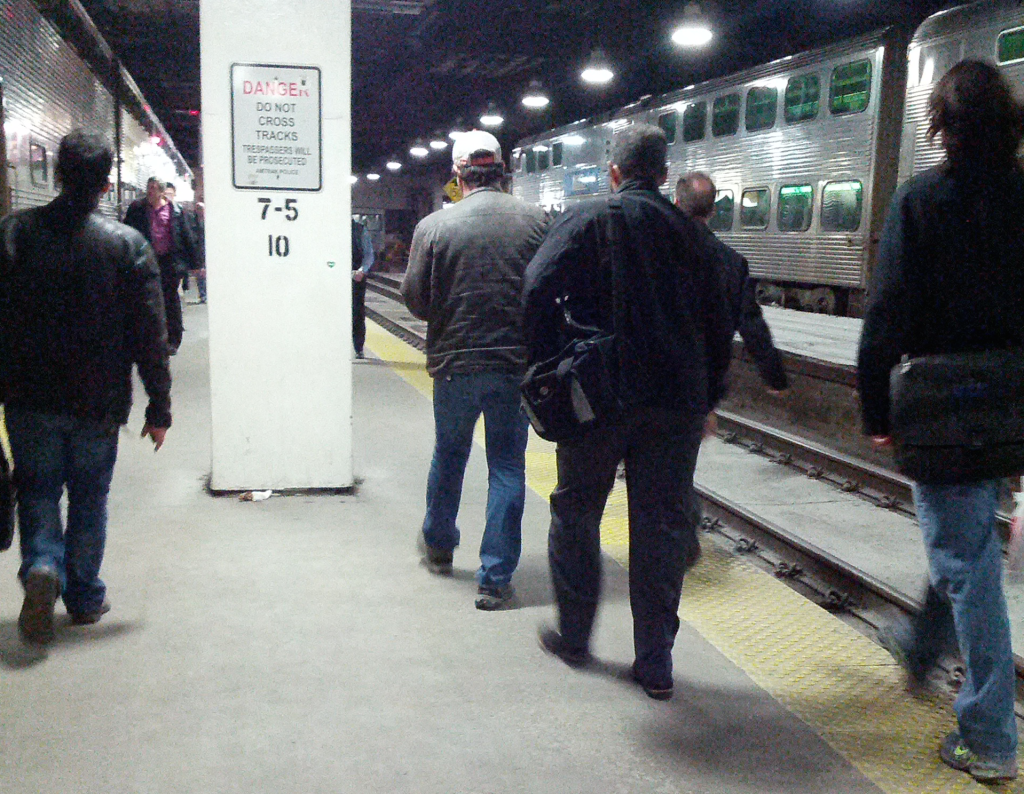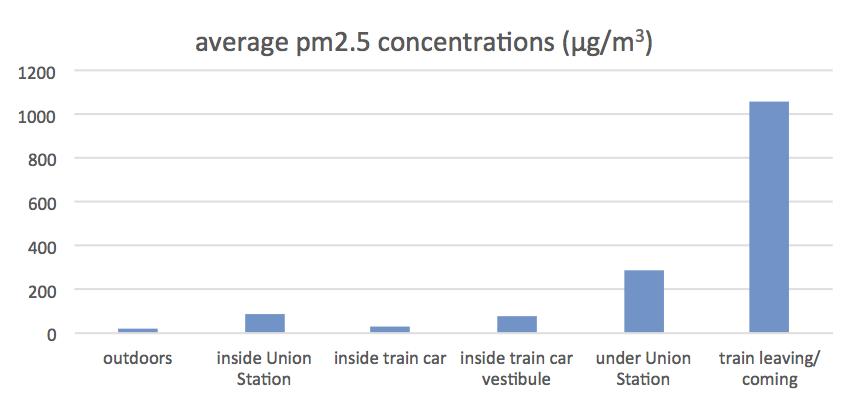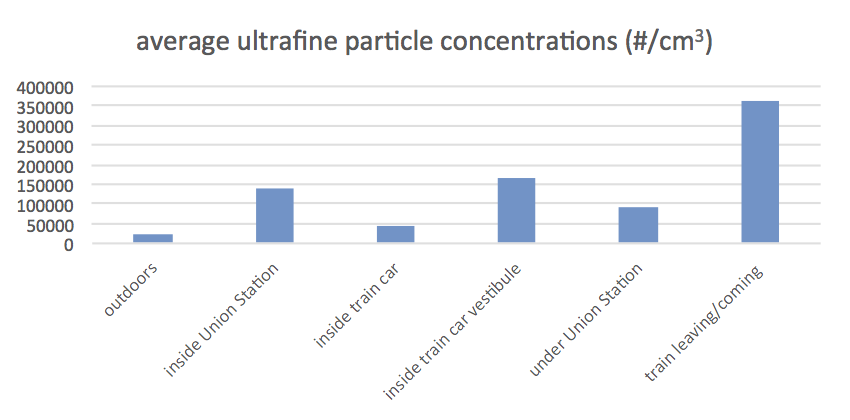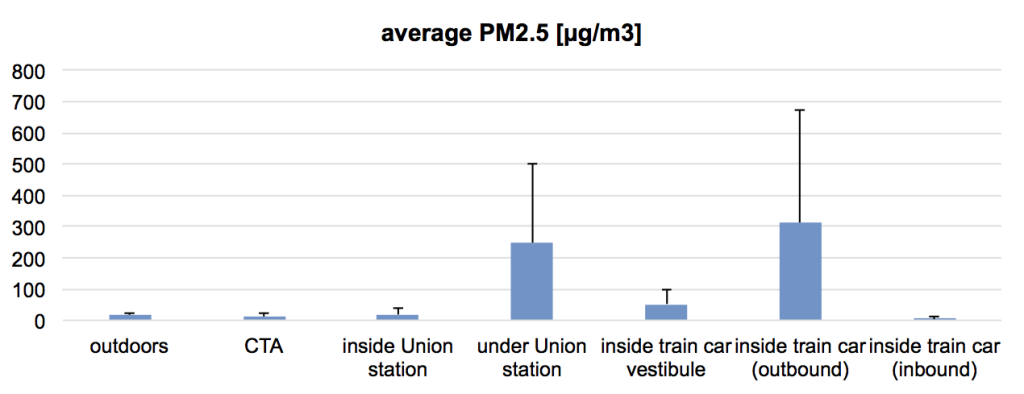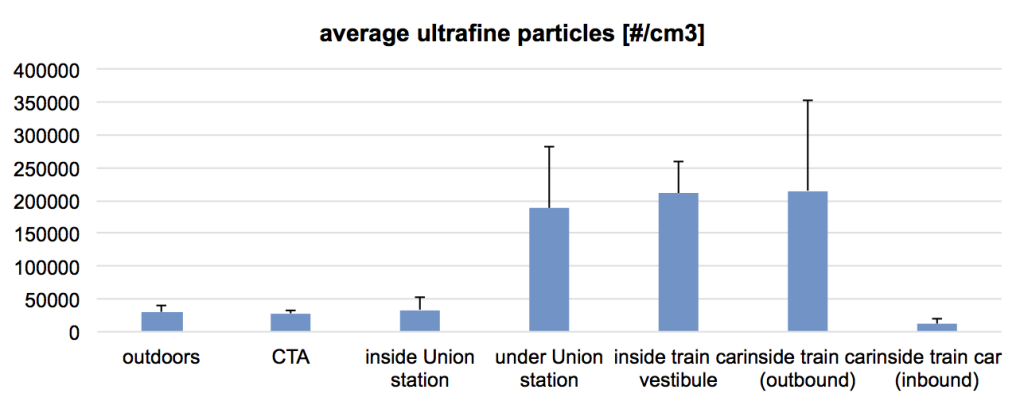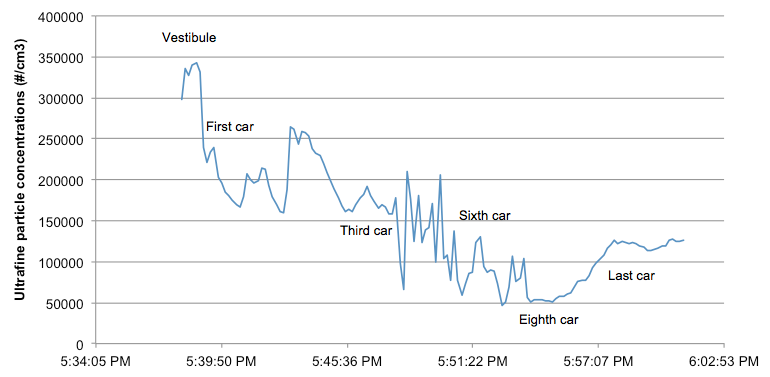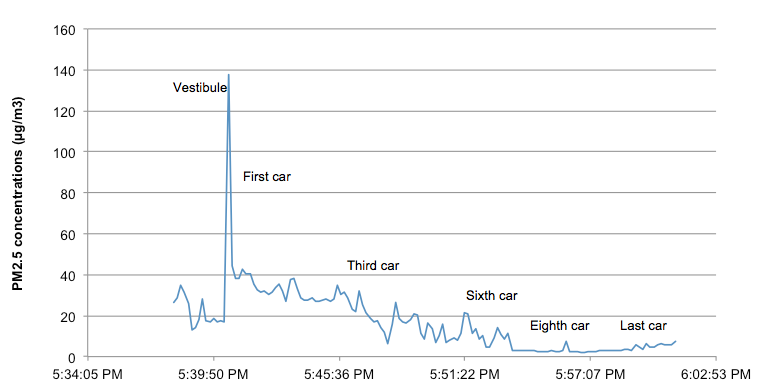Air quality monitoring on Metra trains in Chicago, IL
By Brent Stephens on May 1, 2014
We recently partnered with investigative reporter, Dave Savini, from CBS 2 Chicago to make air quality measurements in and around Metra trains and train stations in downtown Chicago. The Chicago Tribune had previously reported high concentrations of soot (black carbon particles) onboard trains over 3 years ago, which were thought to be caused by re-entrainment of diesel engine exhaust. We know that diesel exhaust emits a number of pollutants that are problematic for respiratory and cardiovascular health, including ultrafine particles, black carbon particles, metals, and VOCs and SVOCs. This report prompted Metra to take action, primarily by installing particle filters on the cabin ventilation systems (MERV 13 instead of MERV 8) and by installing (or planning to install) devices that shut-off the diesel engines as they enter stations. The filters were shown in 2011 to measurably reduce black carbon particle concentrations in the rail cars, which was good to see. I’ve also found links to documents showing that Metra was upgrading ventilation systems to include vent hoods on intakes and exhausts, manual closing of outdoor air dampers, and exhaust deflectors on the locomotives themselves. I’m not sure of the status of these repairs or the extent to which MERV 13 filters have been installed across the fleet.
UPDATE: Watch a video of the CBS 2 story
Fast forward a few years to now: Dave at CBS recently got in touch with me because he noticed particles deposited on the supply vents of Metra train cars, particularly in older train cars, and wondered where they were coming from. We chatted and decided to go on a field visit with him and his crew, which we did in early April 2014. Those deposited particles looked an awful lot like carbon black to me, but later turned out to largely be metal (particularly iron) nanoparticles according to a local environmental lab. Interesting. We also got a better look at the ventilation system that day — it clearly draws outdoor air from a large outdoor air intake on the top of the car (this differs slightly according to car type), and supposedly filters that air and delivers it through supply diffusers throughout the car. On this initial trip we also took some readings with our real-time ultrafine particle monitor (TSI CPC 3007) and PM2.5 photometer (TSI DustTrak 8532). Although our measurements were relatively brief during this trip, we observed the following PM2.5 concentrations (adjusted downward by a factor of 2.5 based on recent gravimetric comparisons):
Day 1
Average outdoor PM2.5 concentrations were 18 µg/m3. The average inside Union Station (above ground) was 88 µg/m3, while inside train cars was only 27 µg/m3. Inside the train car vestibules was higher: 75 µg/m3. Each of these were dwarfed by concentrations measured underneath Union Station in the underground area where trains depart and arrive (average of 284 µg/m3), particularly during periods when trains were actively moving (average of 1062 µg/m3 !). Although there is some uncertainty in these measurements, this value suggests that while trains are arriving and department, using diesel engines at high power and low speeds, emitting into the underground cavern, PM2.5 concentrations accumulate rapidly to as much as 30 times the US EPA limit for 24-hour average limit of 35 µg/m3 and more than 88 times the US EPA limit of 12 µg/m3. These are extremely large exposures. The highest concentrations typically observed in Beijing are between 500 and 700 µg/m3.
Although our ultrafine particle (UFP) instrumentation was limited during these initial measurements, we were still able to report some meaningful data during the same sampling periods (ultrafine particles are more indicative of diesel exhaust sources):
Average UFP concentrations were approximately 25,000 particles per cubic centimeter (#/cm3) during outdoor measurements. This is pretty consistent with other outdoor studies. Inside the train cars, UFP concentrations were almost double this (around 44,000 #/cm3). Underneath Union Station where trains arrive and depart (but not during periods when they were actively moving), UFP concentrations rose to 91,000 #/cm3. This is pretty consistent with concentrations measured in neighborhoods around highly trafficked freeways. Inside Union Station (above ground), UFP concentrations were surprisingly high at about 142,000 #/cm3, and inside train car vestibules UFP concentrations were about 169,000 #/cm3. Finally, when trains were actively arriving and departing – although we had very few data points here – UFP concentrations averaged 362,000 #/cm3. This is about twice as high as that typically observed immediately beside busy roadways.
These are very large particulate matter exposures that are probably of most concern for Metra workers who stand on platforms underneath Union Station near where the train engines are running for long periods of time, as well as for those passengers with existing respiratory problems who may be particularly susceptible to short-term exposures. This also led us to Day 2 of sampling where we targeted measurements on trains.
Day 2
On day 2, we took the same equipment out with the CBS crew again. This time the crew took an outbound train from Chicago to Naperville and an inbound train back to Chicago. Here are their results:
During outdoor periods and on the CTA, PM2.5 and UFP concentrations were relatively similar, hovering around 12-17 µg/m3 (PM2.5) and 30,000 #/cm3 (UFPs). These are fairly common values in outdoor environments. Concentrations of both increased slightly as the team entered Union Station. However, once the team entered the underground platforms in Union Station, both PM2.5 and UFP concentrations increased quickly. Mean PM2.5 concentrations increased to about 15 times higher than outdoors (mean of 246 µg/m3), with a large standard deviation of 256 µg/m3, with some intermittent concentrations being much higher than the average (in fact the highest PM2.5 concentration was almost 1400 µg/m3). UFP concentrations increased to about six times higher than the outdoor average, again with large spikes approaching 400,000 #/cm3. This is about 2-3 times as high as that typically observed immediately beside busy roadways. These are similar to what was observed on Day 1.
Interestingly, the average concentrations inside the train cars on the outbound train to Naperville were the actually highest observed during the visit. The mean PM2.5 concentration inside the train cars was 310 µg/m3 (almost 10 times higher than the 24-hour maximum PM2.5 concentrations allowed by US EPA). There was again a high standard deviation, as some concentrations peaked as high as about 1200 µg/m3. UFP concentrations were similarly high, with an average of 215,000 #/cm3 and a standard deviation of 137,000 #/cm3. The average UFP concentration on the outbound train cars is similar to (or slightly larger than) that typically observed immediately adjacent to busy roadways. These UFP concentrations are approximately equal to that which would be observed with anywhere from about 6 to 12 cigarette smokers on board each isolated half of the train car (although there is considerable uncertainty in this estimate).
What’s really crazy is that the lowest concentrations of both PM2.5 and UFPs were actually measured inside the train cars on the inbound train back to Chicago from Naperville. In this case, the engine was actually pushing the line of train cars and the cars actually had lower concentrations than outdoors, suggesting that there was no re-entrainment of diesel exhaust in this configuration. This suggests that re-entrainment of diesel exhaust in the direction of movement is the primary source of particulate matter inside the train cars. This same basic finding was previously reported in the Chicago Tribune articles as well.
Perhaps even more interestingly, the figures below also demonstrate that this exposure also varied according to position along the train. These figures show UFP and PM2.5 concentrations measured in each train car, starting in the vestibule near the first car adjacent to the engine (the engine was pulling the train cars in this case), followed by measurements in the first car, moving towards the third, sixth, eighth, and final car in time. The highest concentrations appear within the first two cars, decreasing steadily as the team moved to the back of the train. This clear pattern suggests that exposures to UFPs and PM2.5 are highest near the engine and lower towards the back of the train when the engine is pulling the train.
Overall, these are some pretty high particle exposures that remain a problem on Metra trains. Until these problems are addressed in full, you should know that your exposures to fine and ultrafine particles are probably going to be much higher on trains being pulled rather than pushed by diesel engines, and that your exposures on train platforms as you walk to or from your train are also going to be huge.
Many thanks to Parham Azimi, Haoran Zhao, and Akram Ali for their contributions to field work and data analysis.
Filed under: Environmental health | Exposure measurement | Indoor air pollution | Local to Chicago

